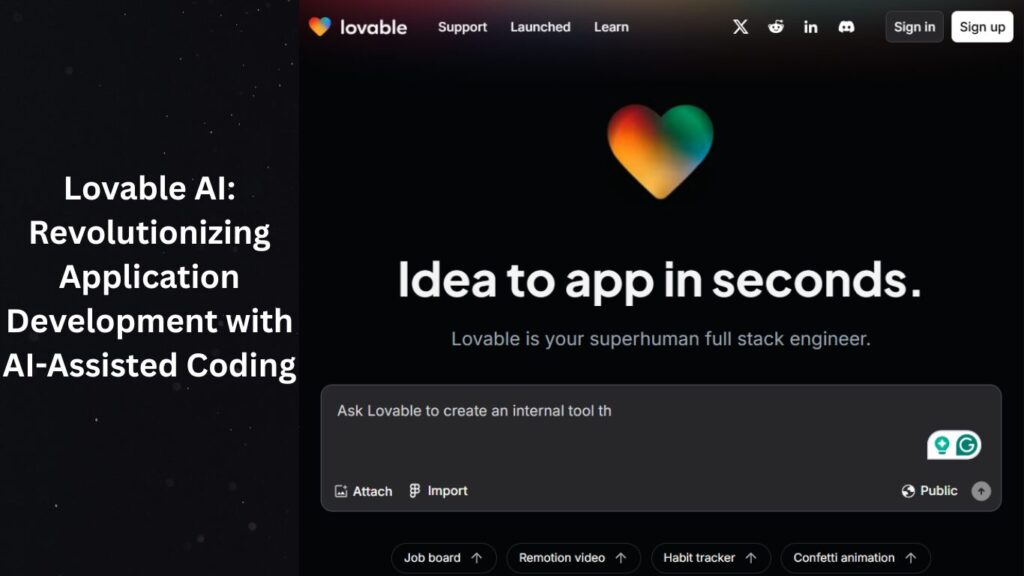Lovable AI: Revolutionizing Application Development with AI-Assisted Coding 2025
In today’s rapidly evolving technological landscape, artificial intelligence (AI) is transforming various industries, and software development is no exception. The integration of AI into traditional coding practices is not just a trend but a necessity for staying competitive and efficient. AI brings numerous benefits to the coding process, making it faster, more accurate, and accessible to a wider range of developers.
Why Integrate AI into Traditional Coding?
Before diving into how Lovable AI leverages these benefits, it’s important to understand why AI is becoming essential in coding:
- Increased Efficiency and Speed: AI automates repetitive tasks, such as generating boilerplate code or formatting, allowing developers to focus on more complex and creative aspects of their work. This leads to significantly faster development cycles, which is critical in today’s fast-paced market.
- Reduced Errors and Improved Code Quality: AI-powered tools provide real-time code analysis, offering suggestions to optimise performance and catch potential bugs early. This results in more robust and reliable code with fewer errors.
- Enhanced Creativity and Problem-Solving: AI can propose innovative solutions and approaches that developers might not have considered, fostering creativity and improving problem-solving capabilities.
- Cost-Effectiveness: By accelerating the coding process and reducing the need for large development teams, AI tools can substantially lower development costs. This makes it easier for smaller teams or individual developers to undertake ambitious projects.
- Accessibility for All Skill Levels: AI-assisted coding tools lower the barriers to entry for beginners, making software development more approachable. For experienced developers, AI serves as a valuable mentor, offering insights and best practices.
Lovable AI exemplifies these benefits, showcasing how AI can revolutionise application development. By leveraging AI, Lovable enables developers to build fully functional applications in a fraction of the time required by traditional methods. To illustrate its power, this article walks through the creation of a discovery platform for AI boot camp graduates—completed in just 30 minutes—highlighting how Lovable is redefining software development and its broader impact on the industry.
The Idea

The concept is simple yet powerful: a discovery platform that connects recruiters with AI boot camp graduates seeking job opportunities. Unlike traditional recruitment platforms that rely on rigid keyword filters or manual resume screening, this tool uses natural language search to match talent with employers seamlessly. For example, a recruiter could type, “Find me a video editor skilled in Blender and After Effects with experience in animation,” and the platform would instantly surface relevant candidates based on their skills, projects, and profiles.
This idea addresses a real-world challenge: boot camp graduates often struggle to showcase their skills to employers, while recruiters waste time sifting through mismatched applicants. By building this platform with Lovable, we can see how AI not only accelerates development but also solves practical problems with elegance and precision. Let’s explore the four-step process that brought this vision to life.
Four-Step Approach to Building the Application


Lovable simplifies app development into four intuitive steps: crafting a Product Requirement Document (PRD), designing the front end, setting up the back end, and integrating a large language model (LLM) for natural language functionality. Below, I’ll break down each step, explain how Lovable enhances it, and provide deeper insights into its efficiency.
Step 1: Product Requirement Document (PRD)
Every successful application begins with a clear roadmap—the PRD. This document outlines the app’s purpose, target audience, core features, and technical requirements. In a traditional setting, creating a PRD involves a product team spending 2-3 days brainstorming, debating features, and refining details. It’s a critical but time-intensive step.
Lovable transforms this with its AI CTO prompt, an intelligent assistant that mimics the expertise of a seasoned Chief Technology Officer. The AI asks specific, probing questions like: “Who is your primary user base?”, “What problem are you solving?”, and “Are there any specific technologies you want to prioritize?” Based on the answers, it generates a comprehensive PRD in just 15 minutes. For the discovery platform, the PRD included a project overview, user personas (recruiters and graduates), feature lists (e.g., search functionality, profile creation), and a recommended tech stack—all tailored to the app’s goals. This speed and clarity cut planning time by over 90%, setting the stage for rapid development.
Step 2: Front End
The front end is the app’s visual and interactive layer—what users see and engage with. For the discovery platform includes a clean dashboard for recruiters, a searchable candidate database, and profile pages for graduates to showcase their portfolios. Traditionally, designing and coding a responsive front end takes 3-4 days, involving wireframes, UI/UX design, and manual coding.
Lovable automates this process using a powerful combination of tools:
- React: For building dynamic, interactive components like search bars and profile cards.
- Vite: A lightning-fast build tool that accelerates development workflows.
- HTML/CSS with Tailwind: For creating modern, responsive designs with minimal effort.
Guided by the PRD, Lovable generates a fully functional front end in 2-3 minutes. It adheres to design principles like simplicity (uncluttered layouts), accessibility (readable fonts and colour contrast), and responsiveness (mobile-friendly interfaces). For example, the platform’s search interface features a sleek input field with real-time filtering, all coded automatically. This efficiency doesn’t sacrifice quality—the result rivals what a skilled developer might produce over days.


Step 3: Back End
The back end is the app’s engine, managing data, logic, and security. For the discovery platform, this means storing graduate profiles, handling user authentication, and processing search queries. In traditional development, setting up a back end takes 2-3 days, requiring developers to configure servers, design databases, and implement APIs manually.
Lovable integrates with Supabase, a backend-as-a-service platform that simplifies these tasks. Supabase provides:
- PostgreSQL databases: For structured storage of user data like skills and experience.
- Authentication: Built-in login systems for recruiters and graduates.
- APIs: Auto-generated endpoints to connect the front end and back end.
In about 10 minutes, Lovable sets up a fully operational backend. For instance, it creates a table for graduate profiles with fields like “name,” “skills,” and “portfolio URL,” all linked to a secure authentication system. This automation eliminates the grunt work of server management, letting developers focus on higher-level tasks.
Step 4: LLM Integration


The discovery platform’s standout feature is its natural language search, powered by OpenAI’s large language model (LLM). This allows recruiters to use conversational queries—like “Find me a data scientist with Python and TensorFlow experience”—and get precise matches from the database. Traditionally, integrating an LLM involves 3-4 hours of work: connecting APIs, fine-tuning prompts, and testing outputs.
Lovable streamlines this to 7-8 minutes. Developers input an OpenAI API key, define the search parameters (e.g., parsing skills from profiles), and test it with sample data. The LLM processes queries by interpreting intent and matching it to structured data in Supabase, all handled behind the scenes. For example, a query like “Show me graduates with web development skills” triggers the LLM to scan profiles for terms like “JavaScript” or “React,” delivering accurate results instantly. This seamless integration makes advanced AI accessible to developers of all skill levels.
Deployment


Deploying an app traditionally involves configuring servers, managing domains, and debugging—often a multi-hour ordeal. Lovable’s one-click deployment feature eliminates this complexity. After completing the four steps, a single click packages the app, uploads it to a hosting service, and makes it live online. For the discovery platform, this meant recruiters and graduates could access it immediately after development. Compared to traditional methods, which might take half a day or more, Lovable’s approach is a time-saver and a stress-reducer, especially for novices.
Time and Cost Analysis


Lovable offers different pricing options based on the requirements.
- Starter($20/month): This plan offers all the features, including private projects and custom domains.
- Launch($50/month): Everything is all the starter plan and 2.5x monthly limits.
- Scale($100/month): Everything in the above plan, including the larger message limits and early access to new features.
- Team: custom-tailored plan for the enterprises.
In traditional software development workflows, a project typically spans 8–10 days, with each phase allocated as follows:
- PRD (Product Requirement Document) takes around 2–3 days, front-end development requires 3–4 days, back-end development another 2–3 days, LLM integration about 3–4 hours, and deployment takes roughly half a day. In contrast, using a streamlined, AI-powered approach like Lovable, the entire process is drastically accelerated. The PRD can be created in 15 minutes, front-end development takes just 2–3 minutes, back-end around 10 minutes, LLM integration about 7–8 minutes, and deployment is nearly instant. The total time shrinks to approximately 25–30 minutes.
- Cost-wise, traditional development might cost $16,250 (at $125/hour for a 130-hour team) or $3,000–$4,000 in lower-cost regions, while Lovable incurs a minimal expense of around $40, covering AI tool subscriptions and basic hosting fees.
These figures highlight Lovable’s edge: it slashes development time by over 99% and costs by a similar margin, making it ideal for rapid prototyping or budget-conscious projects.
Conclusion
Building the discovery platform with Lovable proves that AI-assisted coding isn’t just a trend—it’s a revolution. What once took a team days or weeks now takes one person under an hour, all while maintaining quality and functionality. Lovable’s free AI CTO prompt (available in its video tutorials) further democratises this power, inviting anyone to experiment with app-building. Looking ahead, tools like Lovable signal a future where software development is faster, smarter, and more inclusive, empowering creators to turn ideas into reality with unprecedented ease.
Frequently Asked Questions(FAQs)
What is Lovable AI, and who can use it?
Lovable AI is an AI-assisted coding platform that helps users build applications quickly by automating tasks like planning, coding, and deployment. It’s designed for everyone—from beginner developers to experienced professionals, as well as entrepreneurs or businesses looking to prototype ideas efficiently.
Do I need coding experience to use Lovable?
No extensive coding experience is required. Lovable’s intuitive interface and AI-driven tools, like the AI CTO prompt, guide users through the process, making it accessible for beginners. Experienced developers can also benefit from its speed and automation features.
What types of applications can I build with Lovable?
Lovable supports a wide range of applications, from web platforms (like the discovery platform) to mobile apps and internal tools. Its flexibility allows users to create anything from simple prototypes to complex systems with features like natural language search or real-time data processing.
How does Lovable ensure the quality of the generated code?
Lovable uses modern frameworks (e.g., React, Supabase) and follows best practices to generate clean, efficient code. The AI also performs real-time checks to minimize errors, and users can customize outputs to meet specific needs, ensuring high-quality results.
Is Lovable cost-effective compared to hiring a development team?
Absolutely. As shown in the time and cost analysis, Lovable reduces development costs to around $40 for a project that might cost $3,000-$16,250 with a traditional team. This makes it an affordable option for startups, freelancers, and businesses.





